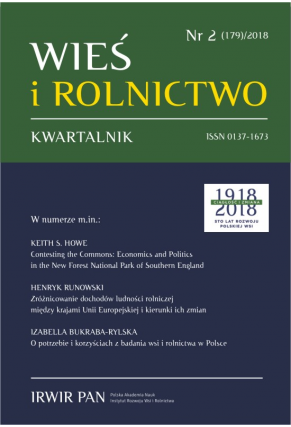Second-Home Owners’ Consumption Patterns and Their Significance for Rural Multifunctionality
DOI:
https://doi.org/10.53098/wir022018/11Keywords:
second homes, consumption patterns, local economy, rural multifunctionality, Finland, PolandAbstract
A highly differentiated business structure strengthens and rejuvenates local economy. Thus, it protects the local economy against external shocks and helps get through transition periods. At the same time, lower degree of specialization and greater economic diversification is reflected in improved well-being of the society. For the goals of sustainable development, it is therefore more desirable to diversify the economy at local scale. However, the attempt should be made to build-up on local resources and specificities, and possibly less on the interest of external investors. The second-home phenomenon, gaining a lot of popularity, has been gradually spreading in rural areas. Yet, it also occurs in zones which, in general opinion, are not attractive in terms of dwelling or tourism functions. Along with second homes there comes a need on the part of their owners and users to meet their demands for various goods and services provided locally. Thus, a question arises whether the scale and variety of needs is sufficient enough to be considered as a potential for diversification of the local economic structure (rural multifunctionality). Hence, the main research objective was to examine second-home owners’ consumption patterns in rural areas and to assess them in the context of implementing multifunctional development. The assessment was carried out based on the size and degree of diversification of the demand for local goods and services and the dynamics in this regard as well as based on the consumer typology (local consumption).References
Adamiak C. (2012). Miejsce drugich domów w zagospodarowaniu obszarów wiejskich województwa kujawsko-pomorskiego. Studia Obszarów Wiejskich, 29, 175–191.
Adamowicz M., Zwolińska-Ligaj M. (2009). Koncepcja wielofunkcyjności jako element zrównoważonego rozwoju obszarów wiejskich. Zeszyty Naukowe SGGW, Polityki Europejskie, Finanse i Marketing, 2 (51), 11–38. DOI: https://doi.org/10.22630/PEFIM.2009.2.51.24
Allanson P., Whitby M. (1996). Prologue: Rural policy and the British countryside. W: P. Allanson, M. Whitby (red.). The Rural Economy and the British Countryside (s. 1–16). London: University of Newcastle upon Tyne, Centre for Rural Economy, Earthscan Publications Ltd.
Bański J. (2009). Typy obszarów funkcjonalnych w Polsce. Warszawa: Instytut Gegografii i Przestrzennego Zagospodarowania PAN (expert assessment), http://www.igipz.pan.pl/tl_files/igipz/ZGWiRL/Projekty/Ekspertyza_typologia.pdf [dostęp: 28.06.2016].
Cox G., Lowe P., Winter M. (1989). The farm crisis in Britain. W: D. Goodman (red.). The International Farm Crisis (s. 113–134). London: Palgrave Macmillan. DOI: https://doi.org/10.1007/978-1-349-10332-4_5
Czarnecki A. (2009). Rola urbanizacji w wielofunkcyjnym rozwoju obszarów wiejskich. Warszawa: Instytut Rozwoju Wsi i Rolnictwa PAN (seria: Problemy rozwoju wsi i rolnictwa).
Czarnecki A. (2017). Going Local? Linking and Integrating Second-Home Owners with the Community’s Economy: A Comparative Study between Finnish and Polish Second-Home Owners. Frankfurt am Main: Peter Lang Publishing. DOI: https://doi.org/10.3726/b11463
Gill I.S., Izvorski I., van Eeghen W., De Rosa D. (2014). Diversified Development: Making the Most of Natural Resources in Eurasia. ECA Regional Flagship Report. Washington D.C.: World Bank. DOI: https://doi.org/10.1596/978-1-4648-0119-8
Heffner K., Czarnecki A. (2011). Wpływ zjawiska drugich domów na rozwój obszarów wiejskich. W: K. Heffner, A. Czarnecki (red.). Drugie domy w rozwoju obszarów wiejskich (s. 131–162). Warszawa: Instytut Rozwoju Wsi Rolnictwa PAN (seria: Problemy rozwoju wsi i rolnictwa).
Heffner K., Czarnecki A. (2015). Linking locally: Second home owners and economic development of the rural community. W: P. Dannenberg, E. Kulke (red.). Economic Development in Rural Areas: Functional and Multifunctional Approaches (s. 185–210). Farnham: Ashgate Publishing (series: The dynamics of economic spaces). Imbs J., Wacziarg R. (2003). Stages of diversification. American Economic Review, 93 (1), 63–86.
Jurek J. (1996). Różnicowanie wiejskiego rynku pracy. W: J. Falkowski, E. Rydz (red.). Wielofunkcyjna gospodarka na obszarach wiejskich (ze szczególnym uwzględnieniem Pomorza Środkowego) (s. 141–149). Materiały XIII Ogólnopolskiego Seminarium Geograficzno-Rolniczego oraz 45 Zjazdu Polskiego Towarzystwa Geograficznego. Słupsk: Polskie Towarzystwo Geograficzne i Wyższa Szkoła Pedagogiczna w Słupsku.
Kłodziński M. (1992). Wielofunkcyjny rozwój terenów wiejskich w Wielkiej Brytanii. Wieś i Rolnictwo, 3–4, 67–77.
Kłodziński M. (1996). Wielofunkcyjność warunkiem aktywizacji gospodarczo-społecznej obszarów wiejskich. W: M. Kozakiewicz (red.). Wieś i rolnictwo w badaniach społeczno-ekonomicznych. Księga Jubileuszowa (s. 154–168). Warszawa: Instytut Rozwoju Wsi i Rolnictwa PAN.
Kłodziński M. (1997). Istota wielofunkcyjnego rozwoju terenów wiejskich. W: M. Kłodziński, A. Rosner (red.). Ekonomiczne i społeczne uwarunkowania i możliwości wielofunkcyjnego rozwoju wsi w Polsce (s. 41–67). Warszawa: Szkoła Główna Gospodarstwa Wiejskiego.
Kłodziński M. (1999). Aktywizacja gospodarcza obszarów wiejskich. Warszawa: Instytut Rozwoju Wsi i Rolnictwa PAN, Centrum Naukowo-Wdrożeniowe SGGW.
Kondracki J.A. (2002). Geografia regionalna Polski. Warszawa: Państwowe Wydawnictwo Naukowe.
Lehtonen O., Tykkyläinen M., Voutilainen O. (2012). Root causes of rural decline in economic well-being in Finland. European Countryside, 4 (3), 217–239. DOI: https://doi.org/10.2478/v10091-012-0025-4
Raczyk A., Majkowska I. (2015). Problemy identyfikacji gmin o zdominowanej strukturze gospodarki. W: R. Brol, A. Raszkowski, A. Sztando (red.). Gospodarka lokalna w teorii i praktyce (s. 62–70) (Prace Naukowe Uniwersytetu Ekonomicznego we Wrocławiu, 391). Wrocław: Uniwersytet Ekonomiczny we Wrocławiu. DOI: https://doi.org/10.15611/pn.2015.391.06
Rantanen M., Hyyryläinen T. (2012). Vapaajan asukkaat paikallisia palveluympäristöjä muovaamassa. Maaseudun Uusi Aika, 2, 59–67.
Siciliano G. (2012). Urbanization strategies, rural development and land use changes in China: A multiple-level integrated assessment. Land Use Policy, 29 (1), 165–178. DOI: https://doi.org/10.1016/j.landusepol.2011.06.003
Skawińska E. (1994). Wielofunkcyjny rozwój obszarów wiejskich w regionie toruńskim. Toruń: Wydawnictwo Naukowe UMK.
Stanny M. (2012). Dynamika zmian demograficznych ludności wiejskiej i jej zasobów pracy. Polityka Społeczna, 7, 1–9.
TEM Raportteja 21/11 (2011). Rakennustutkimus RTS Oy. Loma-asumisen taloudelliset ja työllisyysvaikutukset Suomessa.
Wilkin J. (2008). Wielofunkcyjność rolnictwa i obszarów wiejskich. W: M. Kłodziński (red.). Wyzwania przed obszarami wiejskimi i rolnictwem w perspektywie lat 2014–2020 (s. 9–20). Warszawa: Instytut Rozwoju Wsi i Rolnictwa PAN.
Wojewodzic T. (2014). Dezagraryzacja produkcyjno-ekonomiczna gospodarstw rolnych w Polsce: Próba pomiaru zjawiska. Journal of Agribusiness and Rural Development, 4 (34), 213–223.
Downloads
Article file downloads
Pages
How to Cite
Issue
Section
License
Copyright (c) 2018 Wieś i Rolnictwo

This work is licensed under a Creative Commons Attribution 4.0 International License.










